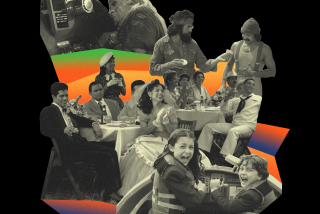Mexican Director, Actor Known as ‘El Indio’ : Film Maker Emilio Fernandez Dies
- Share via
Emilio Fernandez, who created a legacy of socially conscious Mexican cinema through 42 thematically juxtaposed motion pictures, has died.
“El Indio,” as he was known throughout the entertainment world, was 82 when he died Wednesday at his Mexico City home of an apparent heart attack.
Known primarily to American audiences as a sometimes film actor (the bordello bartender in “Under the Volcano”), Fernandez actually was once Mexico’s best known and most significant director.
His more than four decades of work reflected in melodramatic highs the tragedy that was and is 20th-Century Mexico and brought Fernandez many of filmdom’s highest honors, among them the Cannes and International Prize awards.
Plight of Peasants
Beginning in 1943 with “Maria Candelaria,” starring two Fernandez favorites--Dolores del Rio and Pedro Armendariz--Fernandez explored the plight of the Mexican peasant, particularly the Mexican Indian.
(The stocky Fernandez, with his trademark droopy mustache, was born to a Spanish father and an Indian mother in a small village near Hondo, Coahuila, Mexico. Thus the affectionate sobriquet “El Indio.”)
“Maria Candelaria,” which won the 1946 Cannes Festival prize (the festival was not held during World War II), tells of an Aztec beauty scorned by most because of her mother’s reputation but adored by a handsome peasant.
It was vintage Fernandez--a theme of social despair set in the contrasting visual grandeur of the floating gardens of Xochimilco--and it set a standard for contemporary Mexican film makers.
Youthful Revolutionary
Fernandez had been a youthful revolutionary who supported Adolfo de la Huerta in the Sonora revolt of 1920. After De la Huerta’s ouster, Fernandez, by then a colonel, was sentenced to prison. He escaped, went to Washington, D.C., where he worked as a janitor and mastered English and then came to Los Angeles as a busboy at the old United Artists film studio.
In a 1983 interview with The Times, Fernandez recalled his modest start in the film industry.
One day while he was cleaning tables, members of the crew of Douglas Fairbanks Sr.’s “The Thief of Baghdad” spoke about how desperate they were for ideas on an opening sequence. They asked his advice.
“I didn’t say a word. Instead I wrote three short scenes on a piece of paper and handed it to them,” he was quoted as saying.
“The scenes were actually three shots: first, a rich man; then a poor man, and, finally, a thief. They were so amazed at the simplicity of that, and they ultimately used it in the film. The next day I was given a new Ford automobile. A $450 car was worth something at that time.”
John Ford’s Influence
He progressed from that to bit roles in films, and came under the influence of director John Ford. After a government amnesty in the 1930s, he returned to Mexico where the techniques he had learned from Ford, coupled with a personal desire to portray the misery inherent in his native land, were melded into the imposing array of pictures that became his legacy.
“I wanted to show Mexico and its people as they were and had not been portrayed up to this time,” he told The Times.
Of those films, “Rio Escondido” (Hidden River) and “Enamorada” (In Love) probably will be longest remembered; “Enamorada” because he remade it as “The Torch” in English with Paulette Goddard.
Although most of the 42 Fernandez films were consistently popular in Latin America, only “Maria Candelaria” and “La Perla” (The Pearl), based on the John Steinbeck novel, proved commercially viable in the United States.
Fernandez returned to Hollywood sporadically, directing a sequence of Sam Peckinpah’s “Bring Me the Head of Alfredo Garcia,” in which he also performed, and portraying character roles in “Return of the Seven,” “The Wild Bunch” and “Pat Garrett and Billy the Kid.”
Worked With Huston
He also was an assistant director to John Huston in “The Night of the Iguana” in 1964 and became Huston’s choice as Dios Dado, proprietor of the brothel Farolito in “Under the Volcano.”
In recent years, his work had fallen into disfavor and he was relatively inactive. He blamed the current prurient trend in films.
“Film has to be healthy to inspire and entertain and move people to think. What will we leave our children if all we’re making are porquerias (filth)?”
More to Read
Only good movies
Get the Indie Focus newsletter, Mark Olsen's weekly guide to the world of cinema.
You may occasionally receive promotional content from the Los Angeles Times.









